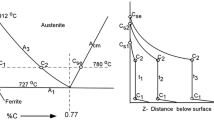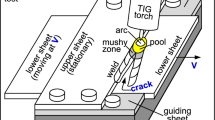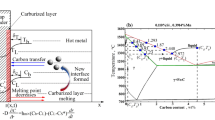Abstract
Direct experimental proof is presented in the paper for the role played by the mass transfer of carbon in accelerating or facilitating the melting and dissolution of pure iron specimens in iron-carbon melts. It is shown that pure iron may readily melt in iron-carbon melts even under conditions where the temperature of the molten phase is considerably below the melting point of the pure iron or low-carbon specimen. A mathematical interpretation is developed for these experimental results that includes the mass transfer of carbon and the unsteady state heat transfer within a moving boundary system. The results of the analysis were found to agree with the experimental data thus providing a basis for further calculations aimed at predicting the melting of scrap in the basic oxygen furnace. These calculations show that scrap melting, facilitated by carbon diffusion from the melt to the scrap surface, begins very early during the process and that melting is retarded and even terminated during the blow when the bath has insufficient superheat to provide the necessary sensible and latent heat required for melting. It follows therefore that the rate of scrap melting in steelmaking processes is accelerated if the removal of carbon in the bath is retarded or if the temperature of the bath is increased rapidly in order to maintain a high level of superheat during the refining process.
Similar content being viewed by others
References
V. Koump, R. H. Tien, and W. J. Kim:Trans. TMS-AIME, 1967, vol. 239, pp. 1305–12.
M. C. Flemings and G. E. Nero:Trans. TMS-AIME, 1967, vol. 239, pp. 1449–61.
R. Mehrabian, M. Kean, and M. C. Flemings:Met. Trans., 1970, vol. 1, pp. 1209–20.
R. H. Tien and V. Koump:J. Heat Transfer, 1970, vol. 92, pp. 11–16.
W. A. Fisher and H. J. Fleischer:J. Metals, 1964, vol. 16, p. 483.
H. W. Meyer, D. A. Dukelow, and M. M. Fischer:J. Metals, 1964, vol. 16, p. 501.
D. D. Burdakov and A. P. Varshavskii:Stal (in English), 1968, no. 8, p. 647.
Kazumi Mori and Hiroyuki Nomura:Study of the Rate of Scrap Melting in the Steel making Process, Tetsu-To-Hagane, 1969, vol. 55, no. 5.
Hiroyuki Nomura and Kazumi Mori:Rate of Dissolution of Iron Into Liquid Fe-C Alloy, Tetsu-To-Hagane, 1959, vol. 55, no. 5.
Y. K. Chuang:Ph.D. Thesis, State University of New York at Buffalo, 1971.
Y. K. Chuang and J. Szekely:Int. J. Heat and Mass Transfer, 1971, vol. 14, pp. 1281–94;alsoInt.J. Heat and Mass Transfer, 1972, vol. 15, pp. 1171–74.
H. S. Carslaw and J. C. Jaeger:Conduction of Heat in Solids, ch. 14, Oxford University Press, Oxford, 1959.
A. N. Tikhonov and A. A. Samarskii:Equations of Mathematical Physics, 1961, vol. 1, McGraw Hill, New York.
Author information
Authors and Affiliations
Rights and permissions
About this article
Cite this article
Szekely, J., Chuang, Y.K. & Hlinka, J.W. The melting and dissolution of low-carbon steels in iron-carbon melts. Metall Trans 3, 2825–2833 (1972). https://doi.org/10.1007/BF02652849
Received:
Published:
Issue Date:
DOI: https://doi.org/10.1007/BF02652849




